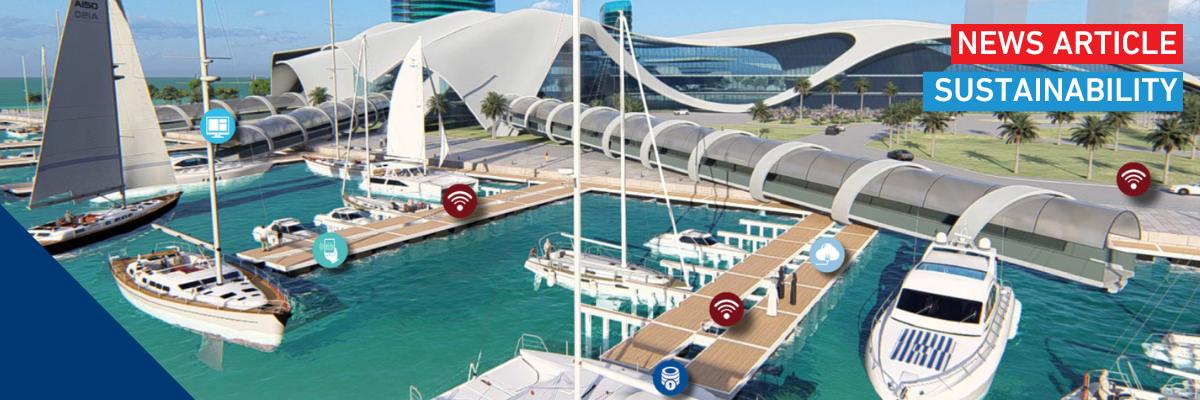Community and climate define future marinas
Interests of local communities, zero pollution demands, extreme weather and rising sea levels pose challenges to yard and marina operation. Design and construction of waterside facilities need to be re-evaluated to create future-proof retreats for the yachting community.
Welcoming yachties with local hospitality, providing the services they need from the local community and from renewable sources, defines the future marina that is sustainable in multiple meanings of that word. Guests will feel welcome, business will be embedded in and co-operative with the local community and resources will be used in environmentally responsible ways.
Marinas and yards are actively researching their future and share their visions at diverse conferences and gatherings around the world. Innovations in energy management and waste reduction help marinas and yards to realise their plans to become the yachting service hubs for decades to come.
Embedding Marinas in Local Communities and Ecosystems
A multitude of aspects needs to be considered in the process of creating a new future-proof marina or restructuring an existing yard or marina. Operations of the staff and infrastructure at the yard or marina itself should result in net zero emissions. There should be excellent energy management, from the electricity connections at the berths to the heating and hot water provision at the sanitary quarters.
Alongside that, well thought out waste management should be arranged in such a way that the guests visiting with their yachts, are positively activated to contribute in waste separation and recycling. A yard or marina needs to be an integral part of its natural surroundings, be part of the ecosystem it is situated in. This may sound as a hard feature to achieve.
Integrating in the natural environment is a quality of design, construction and embedding the marina facilities in such a way, that the original qualities of the location are respected – or even visually enforced. To achieve this, high demands are placed on architects and designers of urban and landscape infrastructure.
The business of yards and marinas best integrates with the local society and business community. Setting up the bars, restaurants, laundry service, tourist services and other spin-offs from a marina, should benefit the local community. All of this poses challenges for existing marinas and yards.
Investing in Sustainable Marina Infrastructure
Building a complete infrastructure for berthing yachts, welcoming the skippers and crews, servicing the yachts and the people on them, lifting boats out of the water for seasonal storage or intensive servicing and maintenance, all require substantial investment.
For a lot of marinas and yards, considering the recent rapid growth of the leisure yachting industry with new yards being established, especially along new cruising grounds, this requires investors like banks or funds.
On the good side of the investment proposition is the fact that construction of marina and yard infrastructure in a sustainable way does not necessarily require higher investment. Maybe the design and architecture phase of the plan for a new yard will be a bit higher, but such plans generally get approval from authorities faster.
The payback period for these investments remains quite long, as the money needs to come in through berth leasing contracts and visiting yachts. This has always been the case with marinas and yards. Rewarding the exploitation of restaurants and bars to local entrepreneurs also brings some uncertainty to the return on investment.
Sustainability in all of its aspects, however, may prove to be the only license to operate at all. No new plans for yacht service facilities are likely to be approved, all over the world, if not with net-zero pollution and beneficial for the local community.
Guidelines for sustainable marina design
“Sustainable design is just good design,” Esteban Bondi argues in Marina World magazine. Biondi is a member of the Marinas Group of ICOMIA and the Chairman fo PIANC (Permanent International Commission for Navigational Congesses, a non-profit organisation for advice on waterborne infrastructure).
“Sustainable Marina design guidelines, such as the PIANC report published in 2023, explicitly state that we should seek pro-active inclusion of the ecological features and identify opportunities for guest experience that provide direct benefits to the local community.”
Weather-proofing Marinas: Adapting to Extreme Weather and Environmental Demands
Record attendance was counted at the Brisbane, Australia, industry conference Marinas24, at the end of May this year. Marina managers, yards, suppliers and landscape architects attended, experiencing the high spirit of opportunity that thrilled the event.
Australian leisure boating, together with the necessary infrastructure, expects substantial growth over the next decade, in preparation for the 2032 Olympic Games. One issue that was discussed in plenary sessions is the occurrence of extreme weather much more often, resulting from climate change.
Together with environmental demands from authorities, this is a very substantial reason to design and construct waterside infrastructure in a way that adapts to the natural environment.
Advancing Architecture in Marina Development
Next September, Monaco Marina Management (MMM) will host the Smart & Sustainable Marina Rendez-vous at the venues of the Yacht Club de Monaco. The issues announced in the programme, as well as the themes in the adjoining prize giving ceremony, reflect what is considered crucial in the development of marinas and yards for the next decades.
New technologies are presented and investigated, financing and investment is researched, and maybe most relevant: architecture in marinas is discussed. It is the architecture that expresses a yard’s or marina identity, it embeds the facilities in the natural environment, it welcomes guests and invites to join in sustainable behaviour.
At the end of the two-day conference, the International Smart & Sustainable Marina Awards ceremony celebrates the best achievers in the categories: Marina, Start-up for marina related technology and Architecture.
Navigating Survival: The Impact of Climate Change on Marina Design
Biondi concludes: “Climate change will transform marina design. Today, very general frameworks are developed to achieve sustainability and social goals. Companies that are already evaluating their sustainability and climate risk profiles and adapting the resultant adaptation strategy may benefit from these changes. Our industry should ensure that the implementation details are appropriate.”
Social and environmental sustainability manifest to be crucial in yard and marine re-construction and design. Building these waterside facilities harmonious in the natural surroundings and making them able to adapt to changing circumstances in terms of water level and weather conditions, is going to be a decisive factor for the future of the yachting community’s home base infrastructure.




